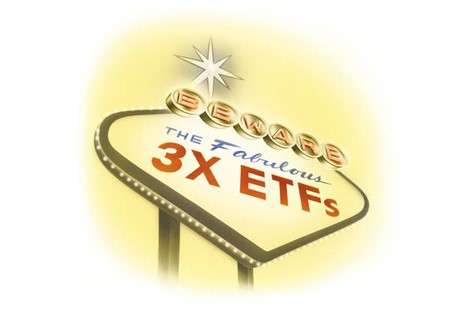
LEVERAGED ETFS: ENHANCED OPPORTUNITIES? OR TICKING TIME BOMBS?
I recently released a video about one of my favourite leveraged ETFs: TQQQ, which seeks a return that is 3x the return of its underlying benchmark for a single day, and want to share some information with you about these attractive but potentially explosive products.
To begin with, we should define a few terms. An exchange-traded fund (ETF) is similar to a mutual fund because it is a pooled investment that holds a portfolio of securities. Unlike a mutual fund, however, ETFs can be bought and sold throughout the day on stock exchanges like ordinary shares. This allows investors and traders to get exposure to indexes such as the Nasdaq-100, whether they are looking for a long-term buy-and-hold strategy or for day trading.
A leveraged ETF is a marketable security that uses financial derivatives and debt to amplify the returns of an underlying index. While a traditional exchange-traded fund typically tracks the securities in its underlying index on a 1:1 basis, a leveraged ETF may aim for a 2:1 or 3:1 ratio.
Unfortunately, leverage can act like a double-edged sword. It can result in gratifying gains, but it can also lead to dramatic losses. Leveraged ETFs are highly risky, tricky to deal with, and potentially explosive.
And then there are inverse leveraged ETFs, which combine elements of both inverse and leveraged products. An inverse ETF is constructed by using various derivatives to profit from a decline in the value of an underlying benchmark. Investing in inverse ETFs is similar to holding various short positions, which involve borrowing securities and selling them with the hope of repurchasing them at a lower price. An inverse ETF is also known as a “Short ETF” or “Bear ETF.”
There are many forms of leveraged ETFs. Here are some of the most popular ones:
The Invesco QQQs (“cubes”) is a popular ETF that tracks the Nasdaq-100 Index.
The Nasdaq-100 Index is composed mainly of technology companies and excludes most financial stocks.
TQQQ is one of the largest leveraged ETFs that also tracks the Nasdaq-100.
QQQ is perhaps best-suited as a long-term investment for those who want broad exposure to the Nasdaq-100 Index.
TQQQ is built for short-holding periods and is best suited for day traders.
Leveraged ETFs have grown in popularity with day traders because the funds can generate returns very quickly, as long as the trader is on the right side of the trade.
Because they are leveraged, these funds are incredibly volatile and risky. Leveraged ETFs are intended for experienced traders who can afford to take on big risks, are able to deal with large losses both financially and emotionally, and are willing to accept the fact that stocks will go up or down on any given day. With two or three times the potential of upside and downside moves, even a slight miscalculation on their underlying properties can damage or destroy an apparently successful trade.
Here are some of the most popular leveraged ETFs on the market and the asset or assets that they track.
| Name | Ticker (Bull/Bear) | Leverage | Underlying |
| Direxion Daily Gold Miners Index Bull/Bear 3x Shares | NUGT/DUST | 3x | NYSE Arca Gold Miners Index |
| ProShares Ultra Bloomberg Crude Oil/UltraShort Bloomberg Crude Oil | UCO/SCO | 2x | Front-month WTI crude futures |
| Direxion Daily Small Cap Bull/Bear 3x Shares | TNA/TZA | 3x | Russell 2000 (small caps) |
| ProShares UltraPro S&P 500/ UltraPro Short S&P 500 | UPRO/SPXU | 3x | S&P 500 |
| ProShares UltraPro / UltraPro Short QQQ | TQQQ/SQQQ | 2x | NASDAQ Composite |
| Direxion Daily S&P Biotech Bull/ Bear 3x | LABU/LABD | 3x | S&P Biotechnology Select Industry Index |
| Direxion Daily Emerging Markets Bull/ Bear 3x | EDC/EDZ | 3x | MSCI Emerging Markets Index |
Finally, there are some tips for traders who have the skills, the experience, and the willingness to ride the ETF roller coaster:

Set Stop Losses
Because of the volatility of EFTs, traders should adopt a disciplined approach to setting stop losses. In addition, because big swings are quite common in these securities, set stop losses wide enough so that you do not get stopped out before a huge run in the direction of your trade idea.
Do Not Hold Shares Overnight
Do not hold positions overnight. Global events can obliterate your trade. It is not uncommon to see leveraged funds gap down 5% to 10% the next morning. Your stop losses will not protect you in such circumstances. Either reduce positions or close them out entirely at the end of the day.
Know the Key Dates
Every week or so, there will be a pivotal event that can affect these funds. For example, oil ETFs tend to trade sideways in the minutes leading up to the Energy Information Administration and Baker Hughes reports. Depending on the overall trend, market moods, and the previous week’s report, some traders prefer to place their bets on the post-report movement. If your hypothesis is proven correct, you can make a large return in a short period of time while risking little capital.
Check the Overall Trend
Finally, always remember that although day trading takes place over a time span that is measured in minutes, the day’s movements are indicative of the bigger picture. Use the daily, hourly and 15-30 minute charts to gauge support and resistance levels from the previous day’s or week’s trading. Usually, an area of strong support and resistance that has been tested multiple times can prove to be a better entry or exit point than a level that appears during the course of the day.
The Bottom Line
Leveraged ETFs are not for the faint of heart. Traders who can live with the volatility can achieve large gains (or losses) on their positions very quickly. When trading these erratic instruments, be sure to check the underlying asset that they track so you can have a sense of direction they will take each trading day.
Furthermore, traders who bet on these funds should have an adequate risk management strategy in place and be ready to close out their positions at the end of each market day.
A Special Caution for New Investors
The most important message for new investors is simple: Don’t invest in something you don’t understand. If you’re not experienced and comfortable with financial derivatives, options contracts, and futures, limit your activities to other investments.
Resources:
- Develop your trading skills with this free real time day trading simulator.
- Check out the most advanced tools for traders and investors: https://tradingterminal.com/
- Learn about one of the best technologies for active trading.
- A Glossary of terms frequently used in day trading.
Would you like to ask Andrew Aziz some questions or share your own experiences? He would enjoy hearing from you at [email protected].






